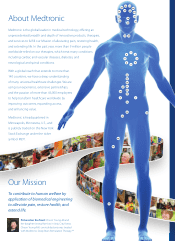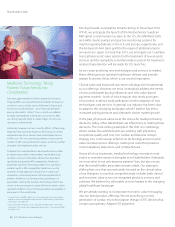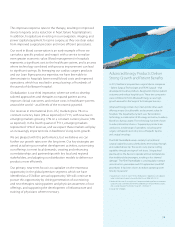Medtronic 2013 Annual Report Download - page 6
Download and view the complete annual report
Please find page 6 of the 2013 Medtronic annual report below. You can navigate through the pages in the report by either clicking on the pages listed below, or by using the keyword search tool below to find specific information within the annual report.
75732me_editorial.indd 2 7/1/13 3:03 PM
Shareholder Letter
2 | 2013 Medtronic Annual Report
Medtronic Technology: Taking
Patients’ Future Needs Into
Consideration
Each year, approximately 60 million magnetic resonance
imaging (MRI) scans are performed worldwide1 to diagnose
conditions such as stroke, cancer, Alzheimer’s disease, and
muscle, bone and back pain – all of which are prevalent
among older adults. Unlike CT scans, which use radiation
to image hard materials in the body such as bones, MRIs
use strong magnetic elds to create images of soft tissue
structures inside the body.
Historically, however, concerns over the eects of these large
magnetic elds and radio frequency (RF) energy on certain
implantable electronic devices have limited patient access
to MRI scans. This was a growing problem, as each year the
number of MRI scans performed increases, as do the number
of people with implanted cardiac devices.2
To address this need, Medtronic developed and now oers
an impressive portfolio of pacemakers, implantable loop
recorders, and neurostimulation devices that have been
specically designed for MRI compatibility. Medtronic’s
proprietary SureScan Technology addresses a signicant
medical need for MRI compatibility. Medtronic recently
received CE mark approval in Europe for its spinal cord
stimulation system designed for full-body eligible MRI. In
addition, Medtronic has developed two generations of
pacemakers utilizing the SureScan Technology, which have
shown no known hazards in certain MR environments within
specied conditions of use. These pacemakers are available in
many parts of the world today.
1 Sutton R, Kanal E, Wilko BL, Bello D, et al. Safety of magnetic resonance imaging
of patients with a new Medtronic EnRhythm MRI SureScan pacing system: clinical
study design. Trials 2008, 9:68.
2 Zhan C, Baine WB, Sedrakyan, A, et al. Cardiac device implantation in the United
States from 1997 through 2004: A population-based analysis. J Gen Intern Med 2008;
23(Suppl 1):13–19.
Len Reed,
Cincinnati, Ohio
Len was able to undergo
an MRI with our
MR-conditional pacemaker
Moving forward, our pipeline remains strong. In Fiscal Year 2014
(FY14), we anticipate the launch of the RestoreSensor SureScan
MRI spinal cord stimulation system in the U.S.; the MiniMed 530G
and 640G insulin pumps and glucose monitoring systems for
insulin-requiring diabetes in the U.S. and Europe, respectively; and
the Endurant II AAA stent graft for the repair of abdominal aortic
aneurysms in Japan. In Fiscal Year 2015, we anticipate our CoreValve
transcatheter aortic valve system for the treatment of severe aortic
stenosis and the Symplicity renal denervation system for treatment-
resistant hypertension will be ready for U.S. launches.
As we create and bring new technologies and services to market,
these oerings must optimize healthcare delivery and provide
greater Economic Value, which is our second imperative.
Clinical value and improved outcomes will always be fundamental
to our oerings. However, we must increasingly address the needs
of new and broader buying inuences and new value-based
payment models – both of which require new levels and types
of economic evidence and justications for the adoption of new
technologies and services. In general, our industry has been slow
to adapt to this changing landscape, which I believe has led to
increased pricing pressure and ultimately slower market growth.
In the past, physicians alone were the ones who made purchasing
decisions; today, other stakeholders are inuencing or making those
decisions. The most striking example of this shift is in cardiology,
where cardiac line administrators are working with physicians
to optimize quality and cost. Our Cardiac and Vascular Group’s
strategy is to continuously enhance its technology and economic
value-oriented service oerings, making our customer presence
more integrated, responsive, and comprehensive.
Across all of our businesses, medical technology innovation must
evolve to meet the needs of a broader set of stakeholders. Ultimately,
we must strive to not only improve patients’ lives, but also ensure
that the overall healthcare system remains viable. Our strategy is
shifting from one that was exclusively focused on the clinical value
of our therapies, to one that comprehensively includes both clinical
and economic value across our integrated products, services, and
solutions. We believe this will enable us to be leaders in the changing
global healthcare landscape.
We are already starting to incorporate economic value messaging
into our latest product oerings. We are launching our next
generation of cardiac resynchronization therapy (CRT) devices that
contain a proprietary AdaptivCRT algorithm.



















